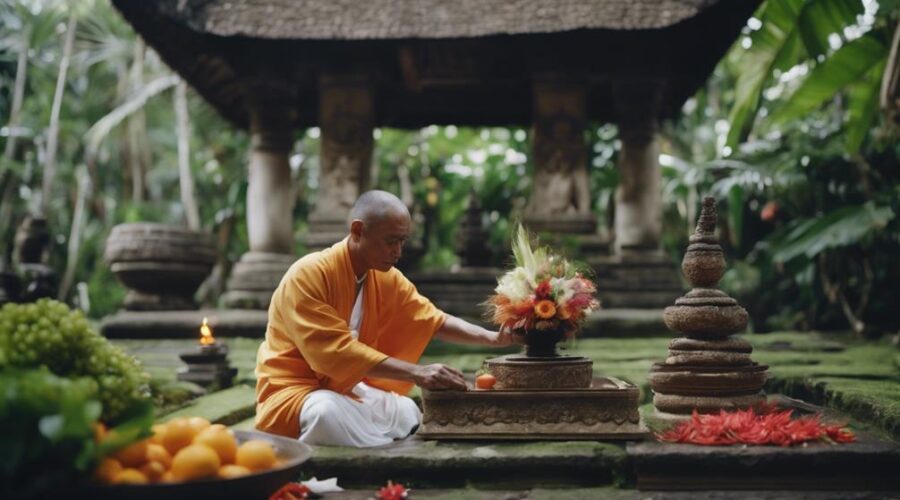What Is the Cleansing Ritual in Bali?
Just as water symbolizes purity and renewal across many cultures, in Bali, it forms the core of a prominent spiritual practice, known as the Melukat or cleansing ritual.
You've probably seen pictures of these ceremonies, where locals and tourists alike bathe in sacred springs, but do you know the profound meaning behind them?
This Balinese tradition, steeped in mystery and spiritual significance, is more than just a fascinating spectacle. Intrigued? Let's unpack the layers behind this ancient ritual, and you might discover how it could offer some fresh perspectives on life itself.
Key Takeaways
- The cleansing ritual in Bali, known as Melukat, is a spiritual practice for purifying the soul and body.
- Melukat has significant cultural importance, preserving Balinese heritage and reinforcing community bonds.
- The ritual involves key elements like holy water, offerings, and mantras, symbolizing purity and spiritual growth.
- Participating in Melukat offers transformative experiences, fostering a deep spiritual connection and enhancing understanding of Balinese spirituality.
Understanding the Melukat Ritual
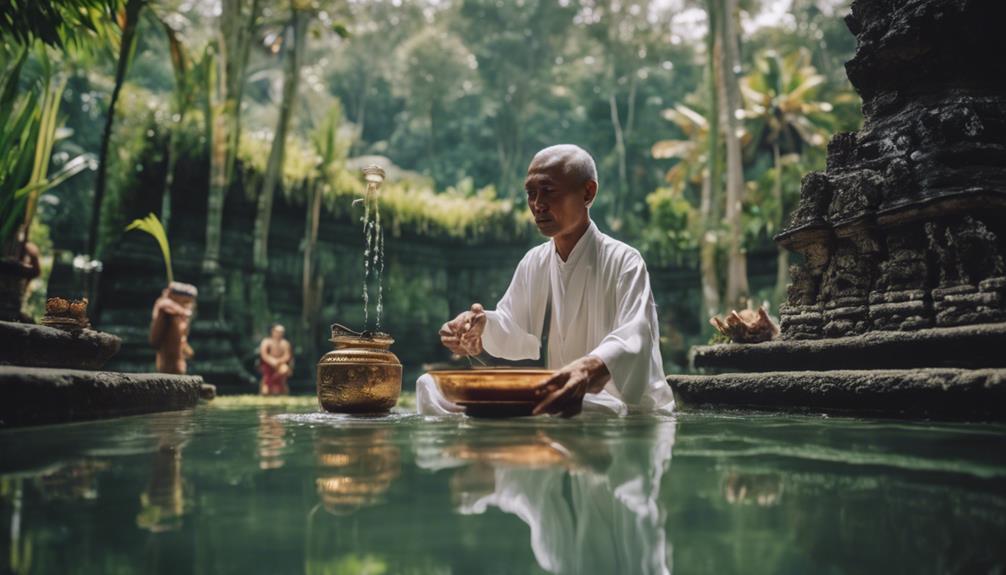
To fully grasp the significance of the Melukat ritual in Bali, you need to explore its spiritual principles, intricate procedures, and cultural implications. The Melukat mythologies provide a fascinating glimpse into the philosophical underpinnings of this ritual. As per the mythologies, Melukat is believed to cleanse the spiritual and physical self, extricating the individual from the grip of unseen negative forces. The ritual symbolism, expressed through specific chants and offerings, is a powerful conduit for this spiritual cleansing.
You'll find that Melukat's intricate procedures are as enthralling as its philosophy. Each step is meticulously crafted, imbued with deep meaning and purpose. From the selection of sacred water sources to the creation of intricate offerings, every detail is carefully considered, reflecting the Balinese emphasis on harmonizing with nature and the divine.
Culturally, Melukat is more than a traditional rite; it's a societal cornerstone, shaping the Balinese way of life and thought. It's a compelling confirmation of the community's resilience, their unwavering faith, and the enduring relevance of their age-old traditions in the face of modern innovation. Understanding Melukat is, hence, a gateway to appreciating the rich tapestry of Balinese culture.
Historical Origin of Melukat
Having recognized the profound spiritual and cultural significance of Melukat, let's now explore its historical roots, which will shed more light on the evolution and enduring relevance of this fascinating ritual. Tracing Melukat's origin is like diving into the depths of Balinese spiritualism, where it's seen as a medium for purification. It's a centuries-old tradition, deeply rooted in Bali's history and religious practices.
Melukat's influence has been significant in shaping the Balinese community's spiritual practices. It manifests the belief that spiritual cleanliness is as critical as physical hygiene, reflecting Ritual Symbolism that transcends the material world. These rituals have been passed down through generations, underscoring their cultural importance and community's faith in them.
Historically, Melukat was believed to cleanse individuals from unseen forces, negative energies, and bad luck. This belief still holds strong in Balinese society. The ritual also symbolizes a spiritual rebirth, a fresh start. Over the years, it has morphed into a transformative experience for many, serving as a testimony to the adaptability and resilience of Balinese culture.
The historical origin of Melukat conveys the dynamic interplay of tradition, faith, and societal needs, painting a vivid picture of the ritual's enduring relevance.
Key Elements in the Ceremony
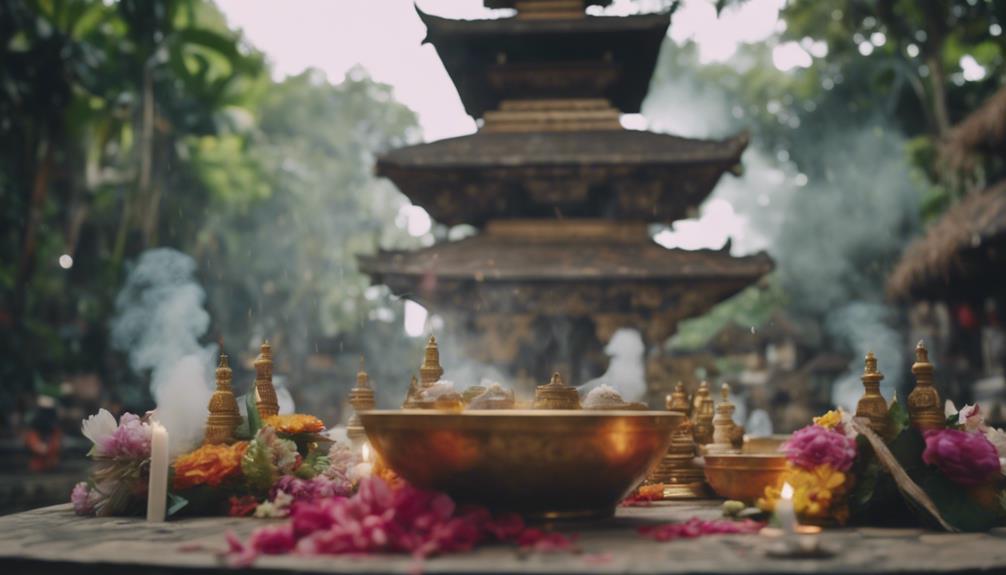
Delving into the key elements of the Melukat ceremony, you'll find that each step is meticulously designed and filled with profound spiritual significance. Ritual symbolism and spiritual elements are integral to this process, reinforcing the ceremony's core purpose – to cleanse and purify the spirit.
One fundamental component is the use of holy water, or 'Tirta'. This water, often sourced from sacred springs, symbolizes purification and renewal. During the Melukat, you're doused with Tirta, signifying the cleansing of negative energies and the renewal of your spiritual self.
Next, the use of offerings, known as 'Banten', encapsulates the spirit of gratitude and respect towards the divine. These offerings, often comprising flowers, food, and incense, represent the Balinese philosophy of Tri Hita Karana, emphasizing harmony with gods, humans, and nature.
To add on, the recitation of mantras forms a central part of the ceremony. These sacred utterances, when spoken, are believed to invoke divine energies, fostering spiritual growth and enlightenment.
The Melukat ceremony is a sophisticated spiritual process, each component richly layered with symbolic and spiritual importance. By understanding these key elements, you start to appreciate the intricate balance of ritual symbolism and spiritual elements woven into the fabric of this profound ceremony.
Preparations for the Ritual
Before partaking in the Melukat ceremony, there's a set of preparations you must undertake to guarantee the ritual's efficacy and respect for the underlying spiritual principles. These preparations aren't merely physical, but also mental and spiritual. They're necessary to ensure that you're fully present and receptive during the ceremony.
1. Ritual Preparatory Tools:
These tools are integral to the ceremony. You'll need flowers, incense, and holy water. Each carries a specific significance and purpose in the ritual. Ensure you prepare them with reverence and respect.
2. Mental and Spiritual Preparation:
This involves meditating and setting your intentions for the ritual. It's about grounding yourself, connecting with your spiritual self, and opening up to the transformative experience the ceremony offers.
3. Dress Code Significance:
You should wear traditional Balinese attire—sarong and sash—during the ceremony. The dress code isn't a mere formality but signifies respect for the ritual and the deities involved. It also helps you connect with the local culture and tradition.
Execution of the Cleansing Ritual
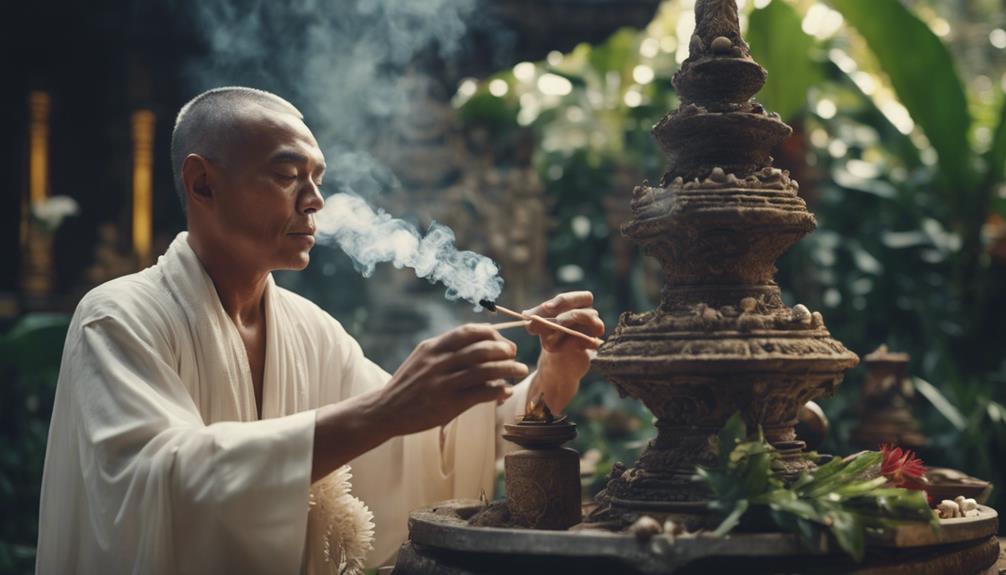
Now, let's shift your attention to the execution of the cleansing ritual.
You'll find it insightful to understand the ritual process overview and the significance of each step.
You'll see how every action contributes to the overall objective of purification and renewal in Balinese culture.
Ritual Process Overview
To fully understand the cleansing ritual in Bali, you need to immerse yourself in the intricate process that it involves. It's a practice deeply rooted in Balinese spirituality, where ritual attire plays a significant role.
- Preparation: The first step involves putting on the traditional attire. This isn't just about aesthetics, but also serves a spiritual purpose, establishing a connection with the divine.
- Cleansing: You're then guided through a series of rituals, each designed to cleanse a specific aspect of your being.
- Closing: The ceremony ends with a reflection period, allowing you to absorb the spiritual energy and blessings received.
This process encourages self-discovery and innovation in spiritual practice, providing a unique lens to view Balinese culture.
Significance of Ritual Steps
Delving into the significance of each step in the cleansing ritual, it's clear that every element has a profound spiritual implication designed to facilitate a deeper connection with your inner self and the divine.
This is where ritual symbolism and sacred materials come in. The use of water, an elemental symbol of purification, seeks to wash away any negative energies you've accumulated. The incense, representing air, helps to elevate your thoughts and prayers. The fire, a symbol of transformation, aims to ignite change within you. Finally, the earth, embodied by the sacred materials used in the ritual, reminds you of your connection to the natural world.
Each step is a well-crafted innovation designed to enhance your spiritual journey.
Significance in Balinese Culture
In Balinese culture, cleansing rituals hold a pivotal role, acting as a bridge between the physical and spiritual domains. They're not merely traditional practices but fundamental tenets of Balinese beliefs. These rituals are transformative experiences that bring about community bonding, enhancing social cohesion and strengthening cultural identity.
To grasp the significance of these rituals, let's explore into three key areas:
- Cultural Reinforcement: These rituals maintain and reinforce the Balinese culture, serving as an important reminder of their distinct identity and rich heritage.
- Spiritual Connection: The rituals are rooted in spirituality, providing a conduit to the divine and fostering inner peace.
- Social Bonding: They offer a platform for social interaction and collective participation, fostering community bonding and promoting unity.
Innovatively, these rituals blend the old with the new, preserving traditional practices while adapting to contemporary contexts. This dynamic nature keeps them relevant and integral to the Balinese way of life. Ultimately, cleansing rituals in Bali are much more than symbolic acts; they're a demonstration to the resilience and vibrancy of Balinese culture.
Personal Stories of Transformation
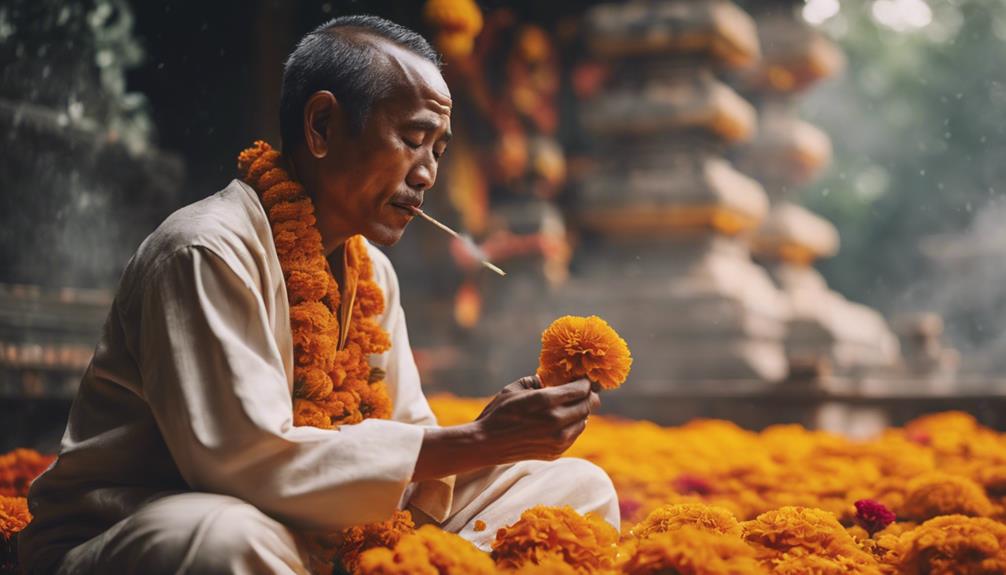
Shifting our focus from the collective to the individual, let's explore how these cleansing rituals in Bali have brought about profound personal transformations. It's not just about the physical act of purification; it's the spiritual and emotional metamorphosis that's truly compelling.
Take, for instance, a businesswoman from New York seeking a fresh perspective in her life—her transformation journey began in Bali. The cleansing ritual served as a catalyst for her personal growth, leading to a complete shift in her lifestyle and mindset. She discovered a new-found sense of peace, and her approach towards business became more centered around sustainable practices.
A married couple, feeling disconnected due to the demands of modern living, found renewed connection and intimacy in their relationship after their shared experience of the ritual. They reported a shift from a state of emotional stagnancy to one of heightened empathy and understanding.
These stories underscore the powerful transformative potential of Bali's cleansing rituals. They offer a unique avenue to self-discovery and personal evolution, providing a fresh lens through which you can view and navigate your life.
Visiting a Melukat Ceremony
As you visit a Melukat ceremony, you'll first need to grasp its underlying principles.
You'll participate actively in this ancient ritual, immersing yourself in its various stages.
The profound impact of the ceremony, a unique spiritual journey, will surely leave an indelible mark on your understanding of Balinese culture.
Understanding the Melukat Ceremony
Bali's Melukat ceremony offers you a profound immersion into the island's spiritual practices, providing a unique opportunity to understand how purification and renewal form an integral part of Balinese Hindu culture.
To explore the ceremony's essence, you need to plunge into its rich tapestry of Melukat Myths and Ritual Variations.
- Melukat Myths: These are stories that give the ritual its spiritual foundation, often presenting the ceremony as a way to cleanse one's spiritual impurities.
- Ritual Variations: The Melukat ceremony isn't uniform, and its innovative variations are based on the participants' spiritual needs.
- Ceremonial Essentials: Understanding the ceremonial elements like holy water, incense, and prayer can enhance your appreciation for the ritual.
This analytical understanding of the Melukat ceremony allows you to appreciate its depth and importance in Balinese culture.
Participating in the Ritual
If you're interested in experiencing this Balinese spiritual tradition firsthand, participating in a Melukat ceremony can offer a deep, transformative experience.
However, like any immersive cultural event, there are certain preparations to take into account. Your ritual attire, for instance, should be traditional sarong and sash, respecting the sacred nature of the event. Women on their menstrual cycle are advised to refrain from participation, reflecting the spiritual expectations of purity.
Additionally, you'd be expected to bring offerings, usually consisting of flowers and incense. Remember, this isn't a tourist spectacle but a deeply personal spiritual journey for many. Engage with an open mind, and you'll find yourself experiencing one of the most authentic expressions of Balinese spirituality.
Impact of the Ceremony
Upon visiting a Melukat ceremony, you'll likely find that the impact of the ritual extends far beyond the physical environment and into the spiritual and psychological domains. This ceremony's environmental impact is multifaceted, encompassing elements of personal well-being and community cohesiveness.
Here are three important effects:
- Economic implications: The ceremony attracts many tourists, boosting local businesses and contributing to Bali's economy.
- Psychological impact: The ritual provides a sense of purification, cleansing participants from negative energies and fostering mental tranquility.
- Environmental impact: The ceremony encourages respect for nature, promoting sustainable practices among the participants and the wider community.
This holistic approach to cleansing reflects the innovative spirit of Bali, blending tradition with progressive practices for a sustainable future.

